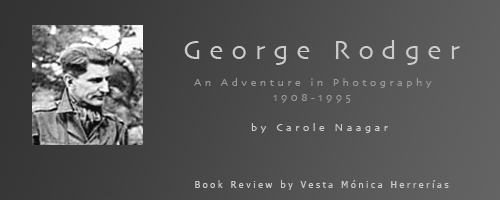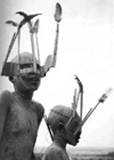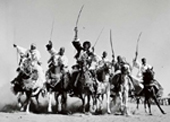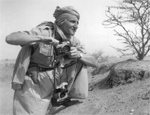
Whenever the Magnum agency is mentioned, the names of Henri Cartier-Bresson, Robert Capa and David Seymour immediately stand out among the founding members list. However, there is another founding member that -perhaps because of his shyness and modesty- has been forgotten: British photographer George Rodger.
This makes Carole Naggar’s biography of Rodger; George Rodger, An Adventure in Photography 1908-1995 a book of great importance that not only allows us to get close to one of the top photo reporters of the 20th Century, but also tells us about an unknown episode regarding the founding of the most important news photo agency of the world.
 Anyone
that reads this book will understand the passion that a photo reporter
has for his work, and realize that to talk about Rodger’s legacy
and his importance, certain aspects of his personal life cannot be left
out. It might come across as an exaggeration, but whenever Rodgers was
away from the battlefields, he suffered from migraines, nightmares and
severe depressions.
Anyone
that reads this book will understand the passion that a photo reporter
has for his work, and realize that to talk about Rodger’s legacy
and his importance, certain aspects of his personal life cannot be left
out. It might come across as an exaggeration, but whenever Rodgers was
away from the battlefields, he suffered from migraines, nightmares and
severe depressions.
It took several years to Rodger to find his true vocation. Since he was a child he was independent, quiet, discreet and adventurous. At 17, due to his bad behavior his father pulled him out of school and sent him to work in a farm. Completely bored, a few moths later he managed to board a cargo ship to the Middle East and did not stop traveling ever since.
Even though he started to take photographs at 15, his dream was to become a writer. During all his lifetime, he recorded his experiences in his dairy, to which Naggar was given access to write his biography. At 21 Roger decided to try his luck in the United States, but 1929 was not a good time to find a job, even so, he survived the Great Depression working in several factories and farms. In 1935, he went back to England, morally defeated and with no money. He casually spotted an advertisement in the BBC´s newspaper The Daily Telegraph, which would change his life. They required a photographer. Rodger got the job with a 6-photograph portfolio, thus embarking in a new phase of adventures and stories, but also of terrible personal tragedies that shaped his character and work.
After a couple of years of working for the BBC and improving his technical knowledge, Rodgers resigned and looked for a news agency to represent him. By then it was clear to him that his calling was to be a photo reporter. He got himself a Leica and a Rolleiflex and set out to take pictures. He started to publish in many magazines and from the very beginning, wrote his own captions. Rodger was a photographer that told stories.
 During
the German bombings of London in1940 Life magazine hired him. The success
of his stories prompted Life to send him to Africa as a correspondent
for two weeks, which became two years. Rodger took advantage of his experiences
during the Great Depression and began to deliver his best work. In time,
he befriended the great photographers of his time: Robert Capa, Hans Wild
and Bill Vandivert.
During
the German bombings of London in1940 Life magazine hired him. The success
of his stories prompted Life to send him to Africa as a correspondent
for two weeks, which became two years. Rodger took advantage of his experiences
during the Great Depression and began to deliver his best work. In time,
he befriended the great photographers of his time: Robert Capa, Hans Wild
and Bill Vandivert.
Many of his pictures rapidly became icons, among them the ones he took at the Berger-Belsen concentration camp in1945, a few days after the liberation of Germany. These photographs, well known all over the world, haunted Rodgers the rest of his life, he refused to look at them for the following 45 years.
During WW II Rodgers was a Life correspondent in 61 countries. He used to say that his goal was to photograph common people in extraordinary situations with a touch of humor. Africa was his passion. He returned there another15 times to do documentaries of several tribes.
The book alternates its narrative with quotes from Rodger’s diaries, his letters to his first wife Cicely (from whom he spent long seasons away) and letters to other friends and relatives. This allows us to reconstruct his puzzling personality and understand why he took such risks during his assignments.
 In
1947 Robert Capa decided to found a news photography agency that secured
the complete independence, protected the copyrights and commercialized
the work of its members. Rodger, Cartier-Bresson and David Seymour were
the only ones invited. Finally, the agency also included Bill Vandivert
and his wife, Rita, who was to be the president and director of the agency’s
New York office. Maria Eisner would be the treasurer and secretary of
he Paris office. To improve coverage, Capa divided the world according
to everybody’s personal interests: Seymour would be in charge of
Europe, Cartier –Bresson of the Far East and China, Vandivert of
the U.S. and Rodger of the Middle East.
In
1947 Robert Capa decided to found a news photography agency that secured
the complete independence, protected the copyrights and commercialized
the work of its members. Rodger, Cartier-Bresson and David Seymour were
the only ones invited. Finally, the agency also included Bill Vandivert
and his wife, Rita, who was to be the president and director of the agency’s
New York office. Maria Eisner would be the treasurer and secretary of
he Paris office. To improve coverage, Capa divided the world according
to everybody’s personal interests: Seymour would be in charge of
Europe, Cartier –Bresson of the Far East and China, Vandivert of
the U.S. and Rodger of the Middle East.
This organization has enabled this agency to overcome the many difficulties and remain one of the most important up to date.
 Carole
Naggar’s book is a remarkable biography of this photographer. Nevertheless,
we would expect a warmer narrative from Nagger, George Rodger’s
close friend and collaborator for more than 18 years. Exacting readers
will be hindered by the conventional chronological order of the 20-chapter
book and a certain -somehow unecessary- details of the photographer’s
personal and intimate life. Apart from these flaws it is quite an enjoyable
book and without question an indispensable material for those interested
in the history of photojournalism.
Carole
Naggar’s book is a remarkable biography of this photographer. Nevertheless,
we would expect a warmer narrative from Nagger, George Rodger’s
close friend and collaborator for more than 18 years. Exacting readers
will be hindered by the conventional chronological order of the 20-chapter
book and a certain -somehow unecessary- details of the photographer’s
personal and intimate life. Apart from these flaws it is quite an enjoyable
book and without question an indispensable material for those interested
in the history of photojournalism.
NAGGAR,
Carole: "George Rodger, an adventure in photography 1908-1995",
Syracuse University Press, New York, 2003.
Other books recommended by Carole Naggar on George Rodger:
George
Rodger: Magnum Opus by Colin Osman and Martin Caiger-Smith (1987)
George Rodger en Afrique Carole Naggar (1984) Catalog of retrospective
exhibitions
Humanity and Inhumanity: The Photographs of George Rodger. Barbican Galleries
in London.
Vesta Monica Herrerias (México): At the moment lives in Paris, where she is doing a PHd on Mexican bourgeoisie at the Sorbonne Nouvelle University. vestamoh@yahoo.com